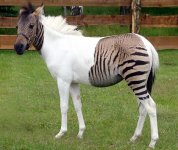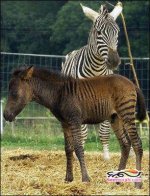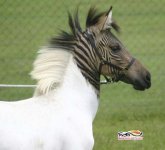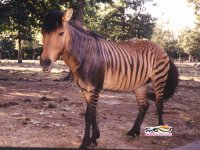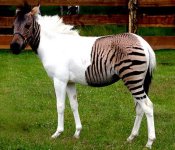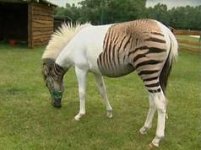♘امیرحسین♞
♘ مدیریت انجمن اسب ایران ♞
A zorse is the offspring of a zebra stallion and a horse mare. It is a zebroid: this term refers to any hybrid equine with zebra ancestry.
The zorse is shaped more like a horse than a zebra, but has boldly striped legs and, often, stripes on the body or neck. Like most other interspecies hybrids, it is infertile.
Cossar Ewart, Professor of Natural History at Edinburgh (1882-1927) and a keen geneticist, crossed a zebra stallion with horse and pony mares in order to investigate the theory of Telegony (pregnancy), or paternal impression. Cossar Ewart used Arabian mares. Similar experiments were carried out by the US Government and reported in "Genetics in Relation to Agriculture" by E.B. Babcock and R.E. Clausen and in "The Science of Life" by H.G. Wells, J. Huxley and G.P. Wells (c.1929).
Zebras, donkeys, and horses are all members of the family equus -- equines. Equines can be crossbred to produce hybrids. They are all slightly different in genetic makeup, but still all equines. That is, horses have 64 chromosomes, zebra have between 44 and 62 (depending on species). Zorses can be male or female, but are sterile since their chromosome count is 63.
Zorses and humans
It soon became apparent that zorses are not the most easiest of the equine family to get along with." -- Trainer Pat Parelli, on working with zorses.
Zorses are preferred over purebred zebras for riding and draught for several reasons. They are usually less temperamental than zebras, although they are still not as easily handled as purebred horses and should not be ridden or handled by novices. They're more horselike shape, particularly of the shoulder region, makes it easier to obtain harness.
Zebras, being wild animals, and not domesticated like horses and donkeys, pass on their wild animal traits to their offspring. Zebras, while not usually very large, are extremely strong and aggressive. It often takes two handlers using chains as lead ropes and standing on either side of the zebra to have any hope of controlling the animal. Similarly, zorses have a strong temperament and can be aggressive.
The zorse is shaped more like a horse than a zebra, but has boldly striped legs and, often, stripes on the body or neck. Like most other interspecies hybrids, it is infertile.
Cossar Ewart, Professor of Natural History at Edinburgh (1882-1927) and a keen geneticist, crossed a zebra stallion with horse and pony mares in order to investigate the theory of Telegony (pregnancy), or paternal impression. Cossar Ewart used Arabian mares. Similar experiments were carried out by the US Government and reported in "Genetics in Relation to Agriculture" by E.B. Babcock and R.E. Clausen and in "The Science of Life" by H.G. Wells, J. Huxley and G.P. Wells (c.1929).
Zebras, donkeys, and horses are all members of the family equus -- equines. Equines can be crossbred to produce hybrids. They are all slightly different in genetic makeup, but still all equines. That is, horses have 64 chromosomes, zebra have between 44 and 62 (depending on species). Zorses can be male or female, but are sterile since their chromosome count is 63.
Zorses and humans
It soon became apparent that zorses are not the most easiest of the equine family to get along with." -- Trainer Pat Parelli, on working with zorses.
Zorses are preferred over purebred zebras for riding and draught for several reasons. They are usually less temperamental than zebras, although they are still not as easily handled as purebred horses and should not be ridden or handled by novices. They're more horselike shape, particularly of the shoulder region, makes it easier to obtain harness.
Zebras, being wild animals, and not domesticated like horses and donkeys, pass on their wild animal traits to their offspring. Zebras, while not usually very large, are extremely strong and aggressive. It often takes two handlers using chains as lead ropes and standing on either side of the zebra to have any hope of controlling the animal. Similarly, zorses have a strong temperament and can be aggressive.


